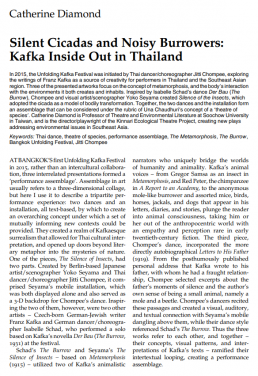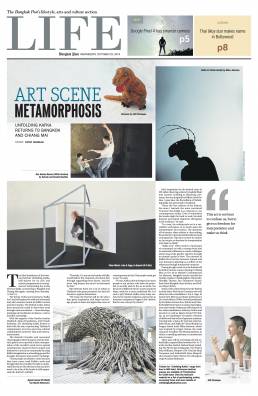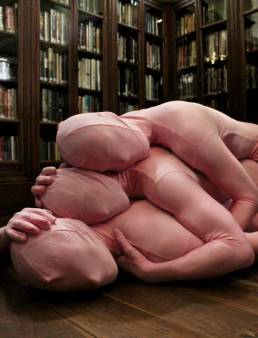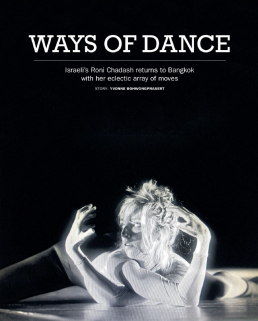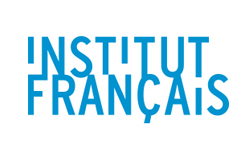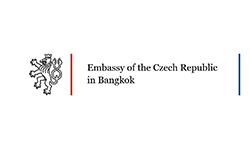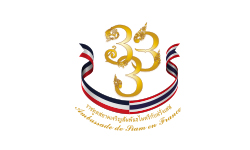“HARD TO BE A GOD” OR “THE THING ITSELF”

Chetana Nagavajara
“The Unfloding Kafka Festival 2019” has brought a number of world-class performances to Thailand. The very loose association with Kafka can serve as a vague guideline, inevitably with a philosophical penchant, and performers go their own way to present their personal modes of looking at the world and communicating the message to the public. The question arises as in what way dance as an art form can communicate, and perhaps more specifically, to what extent it can tell a story. “Hard to Be a God”, which I saw at the Nelison Hays Library on 6 December 2019, set me thinking hard on this very basic question.
My immediate response was that dance does not aim to rival literature and the language of the body does not operate in the same way as the word. The most troubling moment occurred when the lone dancer, Romeu Runa, put his face onto the ground and delivered a soliloquy, via a microphone: I thought it represented a capitulation of sorts that the language of the body was insufficient to carry the message. It need not be so. The one-hour performance was suggestive enough to convey human experiences that should induce the audience to think further and to make its own interpretation.
The physical ambience was perfect. The garden of the Neilson Hays Library was spacious, with the outer perimeter bordering on Surawongse Road, lined up with trees. With a most imaginative lighting, the “stage” had great potential to help communicate the message of the performance. At the very beginning, we could see only vaguely how the dancer emerged, or rather disentangled himself, from the natural wilderness. When he moved to the open space, accompanied by a variety of sound effects and highly nuanced lighting, we could witness how choreographic imaginativeness could express a breadth of human experiences, of course, marked more by suffering than joy. What, I am sure, stunned the audience was the virtuosity of the dancer in creating movements, some of which made us hold our breath because of their acrobatic riskiness. But we never felt that all this was a mere floor exercise: the various movements created impressions, evoked emotions, but they did not quite tell a story.
The attempt at story-telling occurred when two drones appeared one after the other and interacted with the dancer, really a remarkable feat of navigation on the part of the two drone operators (who shared the “curtain” call at the end of the performance.) It was obvious that the protagonist’s predominantly distressful plight experienced only those two moments of respite, signifying perhaps the precarious role of technological interventions in human life. Or were these supposed to represent spaceships coming from another planet? Be that as it may, the two visits could not do much to alleviate the burden of existence. After their departure, man was left again with his loneliness and struggled to survive.
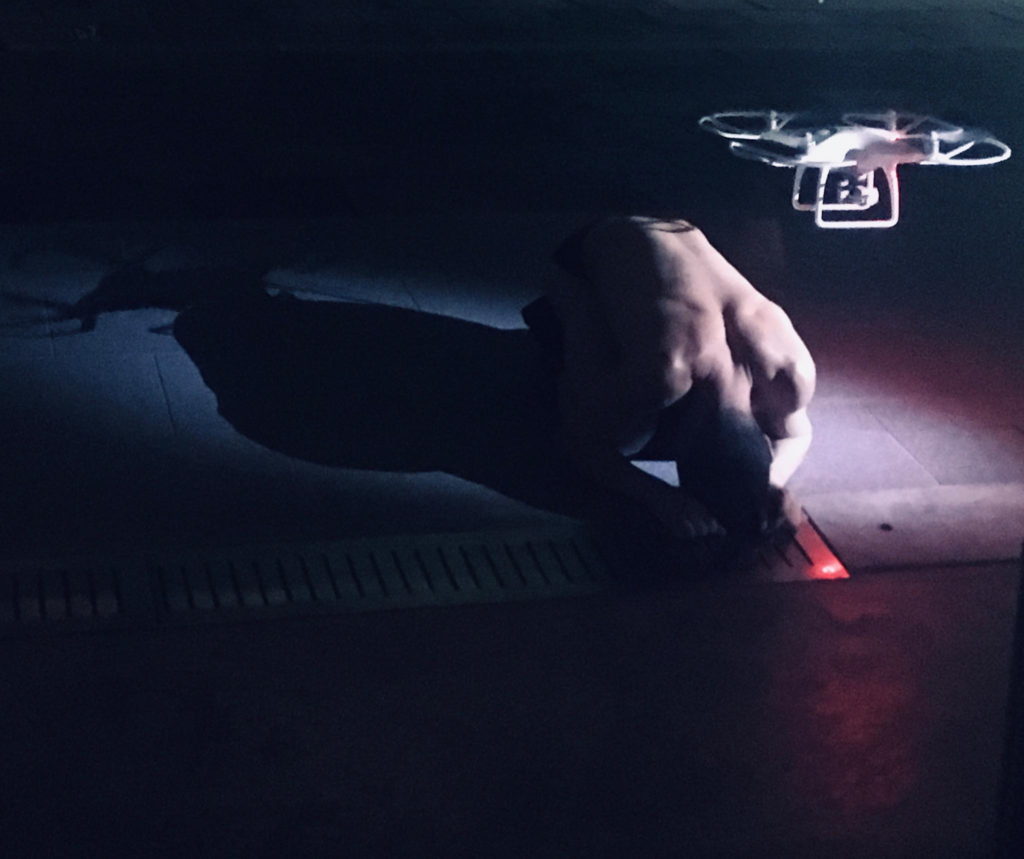
I must confess I enjoyed the performance not strictly on account of what I saw out there (the audience being caged in glass box normally functioning as a Café and having to view the performance through a transparent glass wall.) But the associations, particularly of literary and dramatic kinds, made my experience of this dance performance all the richer. When the dancer performed his monologue, speaking face-down onto the ground, I could almost identify its literary source. My research assistant, a former German major, who was sitting beside me, exclaimed: “Büchner!” I was so glad that what I was trying long time ago to impress upon those innocent young minds struggling with difficult German literary texts was not lost. Yes, the spoken message was very much akin to the famous “Grandmother’s Tale” from Georg Büchner’s “Woyzeck”. According to that story, there is no way out – a complete “huis clos” – from the world as it is, and even excursions into the planetary realms provide no relief, because the sun and the moon are just as arid and lifeless. Many years ago I wrote an essay outlining this lineage of “philosophical cruelty” from Shalespeare’s “King Lear” through Büchner’s “Woyzeck” to Beckett’s “Fin de Partie” (Endgame), but did not touch on Kafka because the essay addressed only the dramatic genre. Nihilism is the word! It can also characterize “Hard to Be a God”.
But the sight of this half-naked man (who towards the end of the performance became fully naked) reminded me starkly of Shakespeare’s “King Lear”, especially the storm scene, and two characters came to mind, the Fool and Edgar, disguised as a mad beggar. Lear, hitherto, revels in his regal authority in spite of his voluntary abdication, finally learns to be humane and sympathetic towards others in need and distress. The old man grows up through hardship amidst climatic calamity. Lear’s words, provoked by the sight of the half-naked Edgar, tell it all.
… Thou art the thing itself: unaccommodated man is no more but such a poor bare, forked animal as thou art … (“King Lear”: Act 3, Scene 4)
The hermeneutic challenge cannot but entice the critic, and I cannot resist the temptation to view the dance performance as a philosophical statement. “The thing itself” was to be vested with various meanings in the course of Western thinking after Shakespeare, including the famous Kantian concept. But to make a choreography express such a philosophical way of thinking was no mean feat of artistic creation. Man’s corporeal nakedness signifies the barrenness of the human condition, culminating in philosophic nihilism. The performance, somehow, did not leave us in a total despair. This was where choreography could produce some form of cathartic effect. The way the dancer created those movements that suggested a struggle of Promethean dimensions was not to be missed. So it was not total nihilism after all. A Buddhist runs the risk of over-interpreting Western thinking so as to align it with his own philosophy of life. It is “hard to be a god”, because even a god cannot relieve man of his suffering. No external source, not even a transcendental one, can be of help. So why not concentrate on the inner strength that can pave the way to “Nirvana”? Will any choreographer be prepared to devise a dance that points in that direction? Can dance be capable of such a challenging task? We shall wait and see. In the meantime, let us applaud a noble attempt like “Hard to Be a God”.




